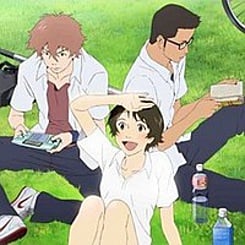Review
by Justin Sevakis,The Girl Who Leapt Through Time
| Synopsis: |  |
||
When 17-year-old Makoto Konno gains the ability to, quite literally, "leap" backwards through time, she immediately sets about improving her grades and preventing personal mishaps. However, she soon realises that changing the past isn't as simple as it seems, and eventually, will have to rely on her new powers to shape the future of her and her friends. |
|||
| Review: | |||
“The Girl Who Leapt Through Time” is anime of rare pedigree. Director Mamoru Hosoda, the Ghibli refugee originally slated to helm Howl's Moving Castle, Gainax's master character designer Yoshiyuki Sadamoto and longtime Ghibli art director Nizo Yamamoto coming together at Madhouse to adapt a story by Paprika author Yasutaka Tsutsui? Sounds like it should be absolute magic… and it very nearly is. We meet Makoto Konno, an outgoing high school girl living a daily life of fun. She's not the best student in the world, but she has two of the best friends in the world - Kousuke, who's the strong, smart dependable type, and Chiaki, who is a fun-loving slacker. They spend their days together goofing off, singing karaoke and playing catch. But on this particular day, things aren't going so well for her. After failing a pop quiz, nearly setting her cooking class on fire, and enough physical accidents to fill a Buster Keaton movie, she gets killed when the brakes on her bike stop working, sending her directly into the path of an oncoming train. … Except she doesn't die. Rather, she finds herself a few feet away, a few seconds earlier, and more or less, safe. Freaked out, she consults her aunt, who tells her she's simply time-slipped, and that it happens all the time. Soon, she finds she can control her time slipping by taking a flying leap. Of course, this power is way too much fun not to abuse. When the time in the karaoke room runs out, she leaps back a couple hours earlier and starts all over again. When she knows what's on a test, she leaps back and takes it over again. If she wants to oversleep, all she has to do is jump and she's right on time. Soon, she's fixing up friends, correcting her mistakes, and gleefully going back and forth trying to make life better. It almost goes without saying that she unintentionally makes things worse, and in repeated moments, manages to dig herself into deeper and deeper trouble. The Girl Who Leapt Through Time has more in common with some of the best shoujo manga than Tsutsui's other recently-animated work Paprika. The maturity, the gravity, and the deep symbolism of the latter has been replaced here with the wistful buoyancy that only the Japanese seem to be able to associate with high school. The winding, narrow streets of suburban Tokyo haven't looked this gorgeous since Whisper of the Heart. Makoto blasts gleefully from scene to scene, knocking into garbage cans and plowing into classmates at a record pace, trying to fix things but making a mess. At one point, her best friends are asking her out on dates. Upset that the relationships went there, she makes attempt after attempt to go back and steer the conversations in another direction. When they finally they turn their attentions elsewhere, she finds she's jealous! It's like “Run Lola Run” meets “Groundhog Day,” where the most important thing is keeping her happy little world of friends intact, without realizing she's ignoring the needs of others. So, what's missing? It doesn't really come together. While the first two thirds of the movie are a blast, the last third derails badly, shifting into something much more desperate and requiring what is nearly a Deus Ex Machina to explain why it all took place. Major questions are left entirely unanswered, as the film prefers to fake us out with non-endings to the point where the real ending feels drawn out. We never do find out if Makoto's “Aunt Witch” is anything more than an occasional confidant, or the relevance of the painting she's restoring. These are not minor plot threads. I have no way of knowing if this is an issue with Tsutsui's story or screenwriter Satoko Okudera's adaptation, but regardless, this needed a few more rewrites. The good news is that the rest of the film is so much fun that this seems like a minor concern. The characters, Makoto and Chiaki in particular, are so lovable that spending time with them is a joy. Makoto, with all her high-spirited but thoughtless energy, feels like Sana-chan from Kodocha grown up. Chiaki feels like a shoujo version of Ichigo from Bleach. Voices supplied by live action teen actors Riisa Naka (from the Japanese drama version of My Boss, My Hero) and Takuya Ishida (Night Time Picnic) lend just the right amount of realism (I much prefer this approach to voice acting over the use of traditional seiyuu). Yoshiyuki Sadamoto's sumptuous linework takes simple curves and makes them so compelling, we'd be content if the characters did nothing but sit there. As Makoto jumps, she learns more and more about what the people around her are really thinking, and how much of a self-absorbed bubble she's been living in. The lessons she learns about herself and her friends are heartwarming and triumphant. If only the conclusion could have taken the ball and run with it, we could have had a masterpiece. But instead, we'll have to settle for “great.” Like Makoto, we'll just have to deal with it. |
| Grade: | |||
|
Overall : A-
Overall (sub) : A-
Story : B
Animation : A
Art : A+
Music : A-
+ Unbelievably fun and beautiful. Truly lovable characters. |
|||
| discuss this in the forum (42 posts) | | |||
| Production Info: | ||
|
Full encyclopedia details about |
||